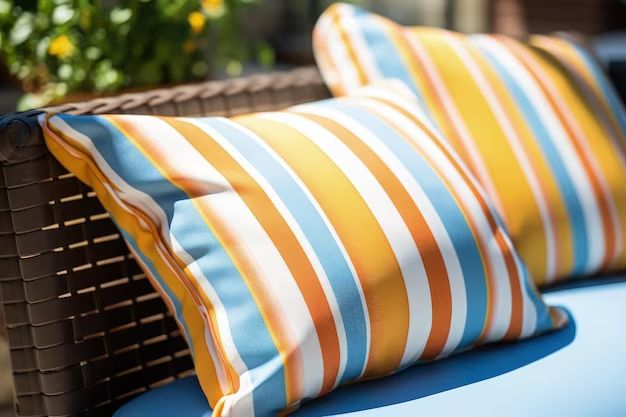Outdoor pillows can add a lovely decorative touch to your patio, deck, or outdoor living space. However, because they are exposed to the elements, outdoor pillows require some special care and consideration to keep them looking their best and lasting a long time. Proper materials, construction, and ongoing maintenance are key to keeping outdoor pillows safe from mold, mildew, fading, and wear and tear.
Page Contents
What materials work best for outdoor pillows?
When selecting outdoor pillows, focus on performance fabrics that are designed to withstand sun, moisture, and weather. Here are some top options:
- Acrylic – Acrylic fibers are colorfast, UV-resistant, and repel water. Look for 100% solution-dyed acrylic.
- Polyester – Polyester resists fading in sunlight and dries quickly after getting wet.
- Olefin – Extremely colorfast and mold/mildew resistant. Olefin is a good budget option.
- Cotton – More prone to fading and mold but very breathable. Look for specially treated outdoor cotton.
- Sunbrella – Popular name brand fabric made from durable, all-weather acrylic.
Avoid common indoor/outdoor pillow fabrics like linen, rayon, silk, or velvet as they will not hold up outside.
How should outdoor pillows be constructed?
The construction of the pillow is also important for outdoor performance and longevity. Look for these outdoor-friendly features:
- Well-stitched seams reinforced for durability.
- Zipper closures allow removal of pillow cover for cleaning.
- Serged edges prevent fraying.
- Poly-fill stuffing resists moisture and mildew.
- Water-resistant lining or coating on back of fabric.
Also ensure the fabric has been treated for UV protection, water repellency, and/or stain resistance.
Keeping Outdoor Pillows Clean
To keep outdoor pillows looking fresh, ongoing cleaning and maintenance is needed. Here are some tips:
Regular spot cleaning
Check pillows frequently for stains from food and beverages or dirt. Use a damp cloth with mild soap and gently spot treat any stains. Allow to fully air dry before placing back outside.
Rinse off debris
Rinse pillows with clean water to remove pollen, dust, leaves, or other debris that collects on them. Allow to fully dry before returning outside.
Wash removable covers
If pillow covers can be removed, periodically machine wash them in cold water on a gentle cycle. Air dry.
Deep clean mildew
For pillows that get mildew spots, mix together:
- 1/2 cup baking soda
- 1/2 cup vinegar
- 1/4 cup oxygen bleach (such as OxiClean)
- 1 gallon warm water
Submerge pillows and soak for 4-6 hours, then rinse clean. Air dry in direct sunlight.
Disinfect with bleach
To kill bacteria and thoroughly disinfect, add 1/2 cup bleach to 1 gallon of water. Soak pillows for 10 minutes, then rinse with clean water. Allow to completely dry before placing back on patio.
Storing Outdoor Pillows in Winter
Cold winter weather can damage outdoor pillows. When freezing temps arrive, properly store pillows indoors until spring.
Dry thoroughly before storing
Wet or damp pillows can breed mildew when packed away. Before storage, machine dry removable covers and air dry pillow inserts completely.
Use breathable storage bags
Store pillows in cotton pillowcases or breathable space bags, not plastic. Plastic traps moisture and can cause mold.
Add mothballs as pest deterrent
Place cedar blocks or mothballs in storage bags to help repel insects and prevent larvae. Just don’t store fabric touching mothballs.
Store in clean, dry area
Choose an indoor area away from moisture, direct sunlight, and extreme temps for storage. A closet, basement, or under bed works well.
| Storage Area | Pros | Cons |
|---|---|---|
| Closet |
|
|
| Basement |
|
|
| Under bed |
|
|
Refreshing Outdoor Pillows Each Season
Some easy refresh tips will keep outdoor pillows looking their best season after season:
Fluff dried inserts
If pillow inserts compressed in storage, toss them in the dryer on air fluff setting to re-loft.
Mend loose seams or tears
Hand sew any loose threads, ripped seams, or tears before placing back on patio.
Patch faded fabric
Use fabric glue and small swatches of coordinating fabric to conceal overly faded or worn spots.
Freshen with fabric spray
Lightly spritz outdoor pillows with a fabric refresher spray. This removes musty odors.
Add new inserts periodically
Replace flattened or degraded filler every 2-3 years to revive pillow shape and comfort.
Conclusion
Outdoor pillows require some simple maintenance to withstand the effects of sun, rain, dirt, and seasonal storage. By selecting suitable all-weather materials, routinely cleaning, and properly storing pillows when not in use, you can keep them looking fabulous year after year. Handle outdoor pillows with care and they will become a durable, lasting part of your outdoor oasis.
